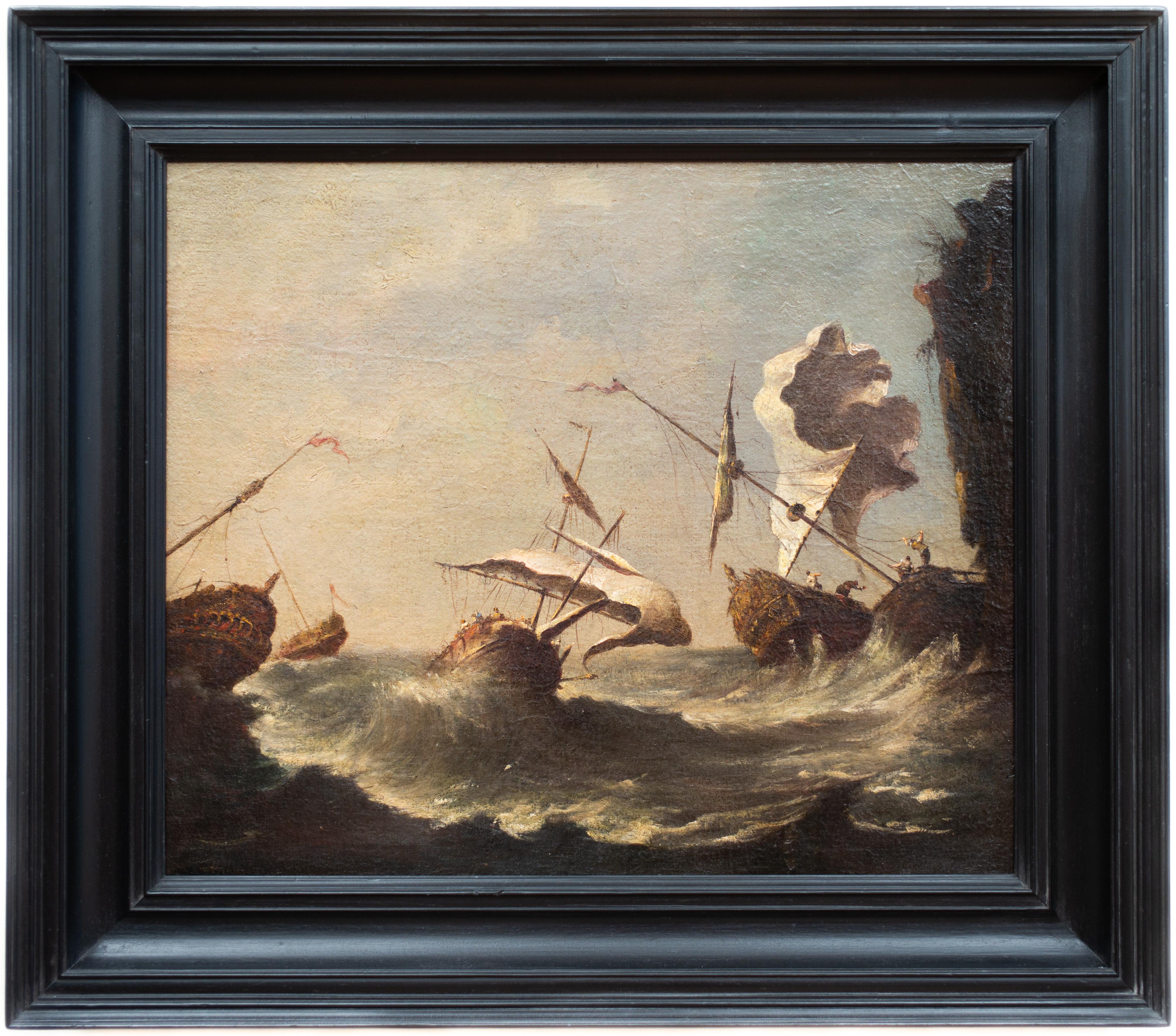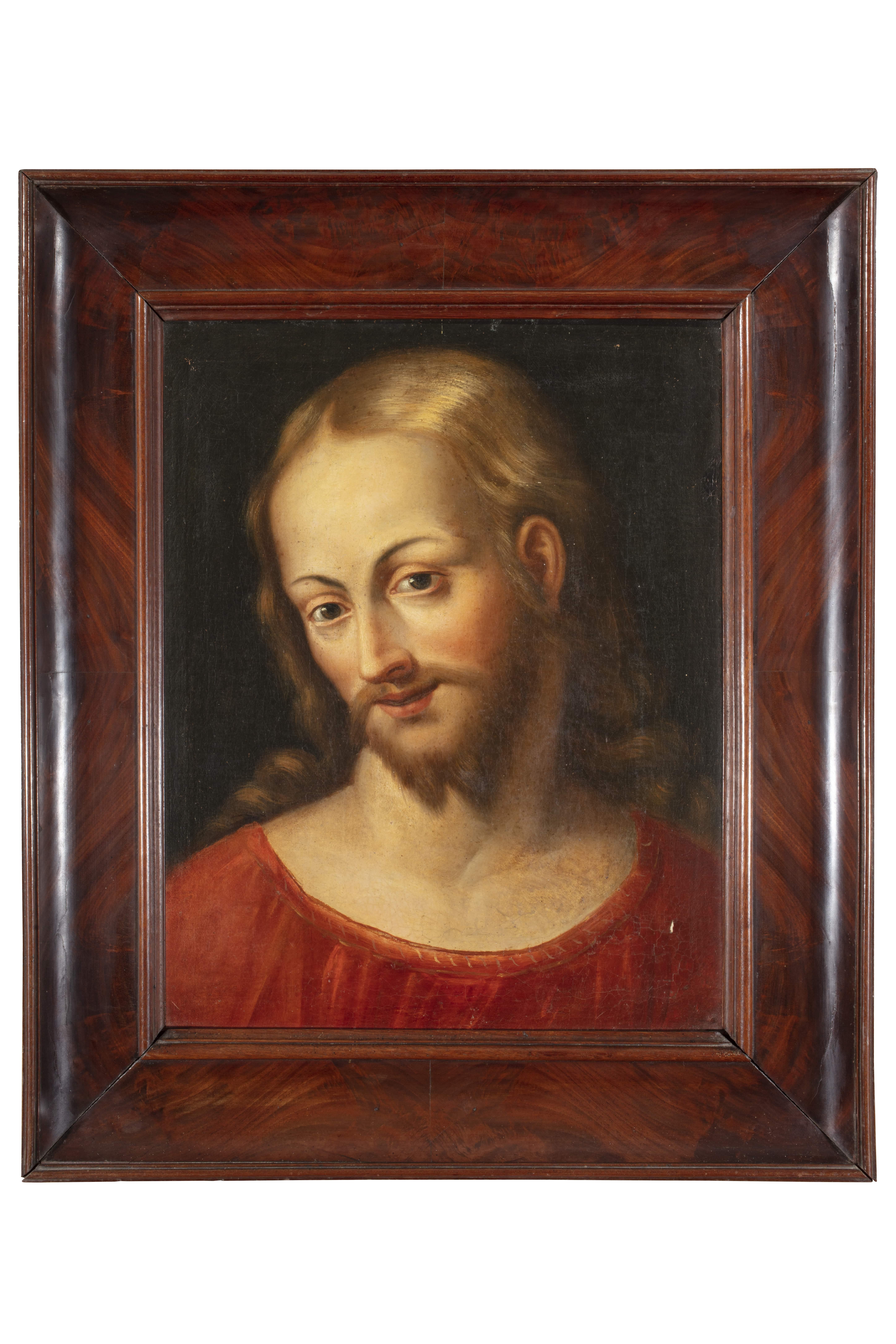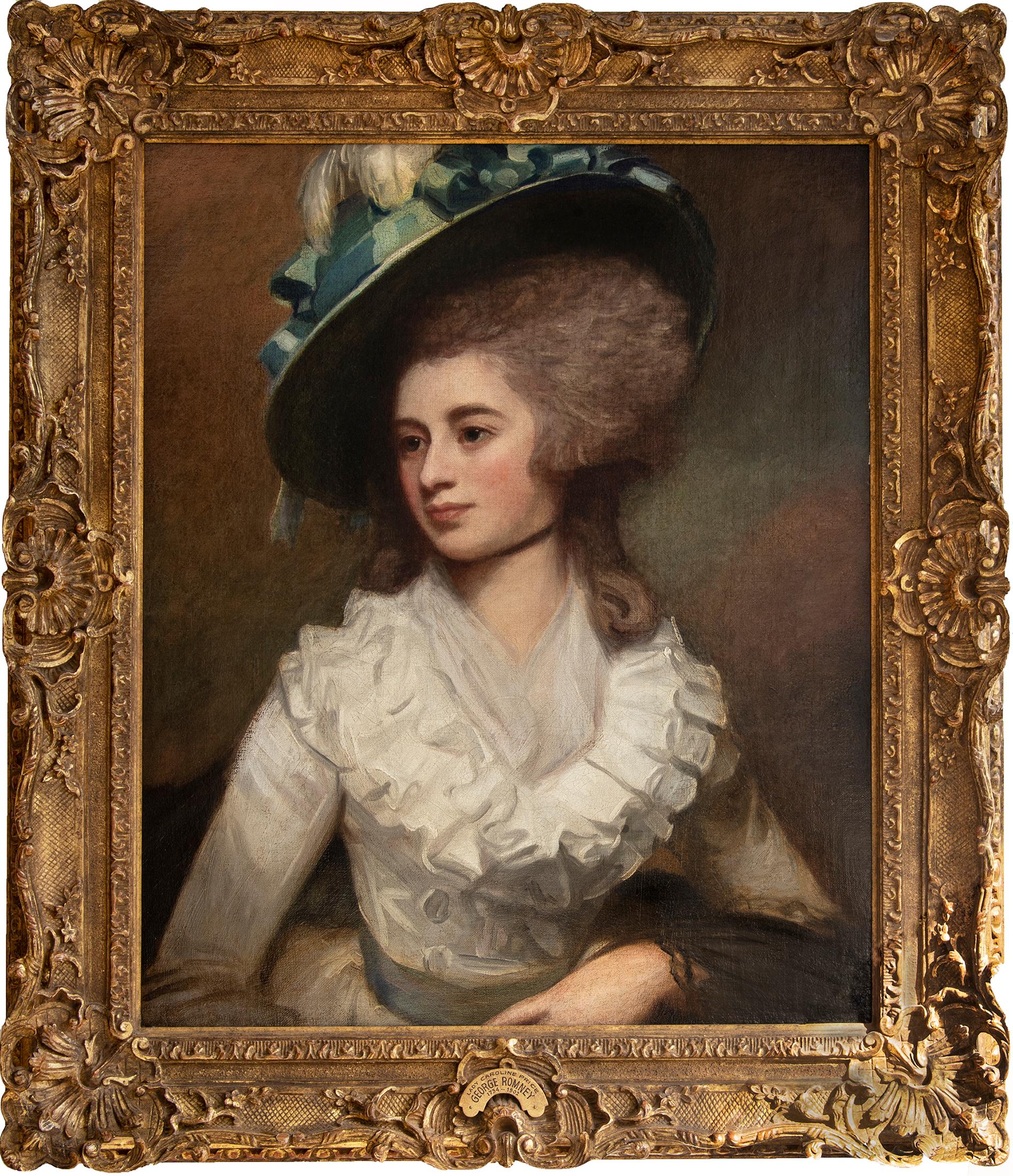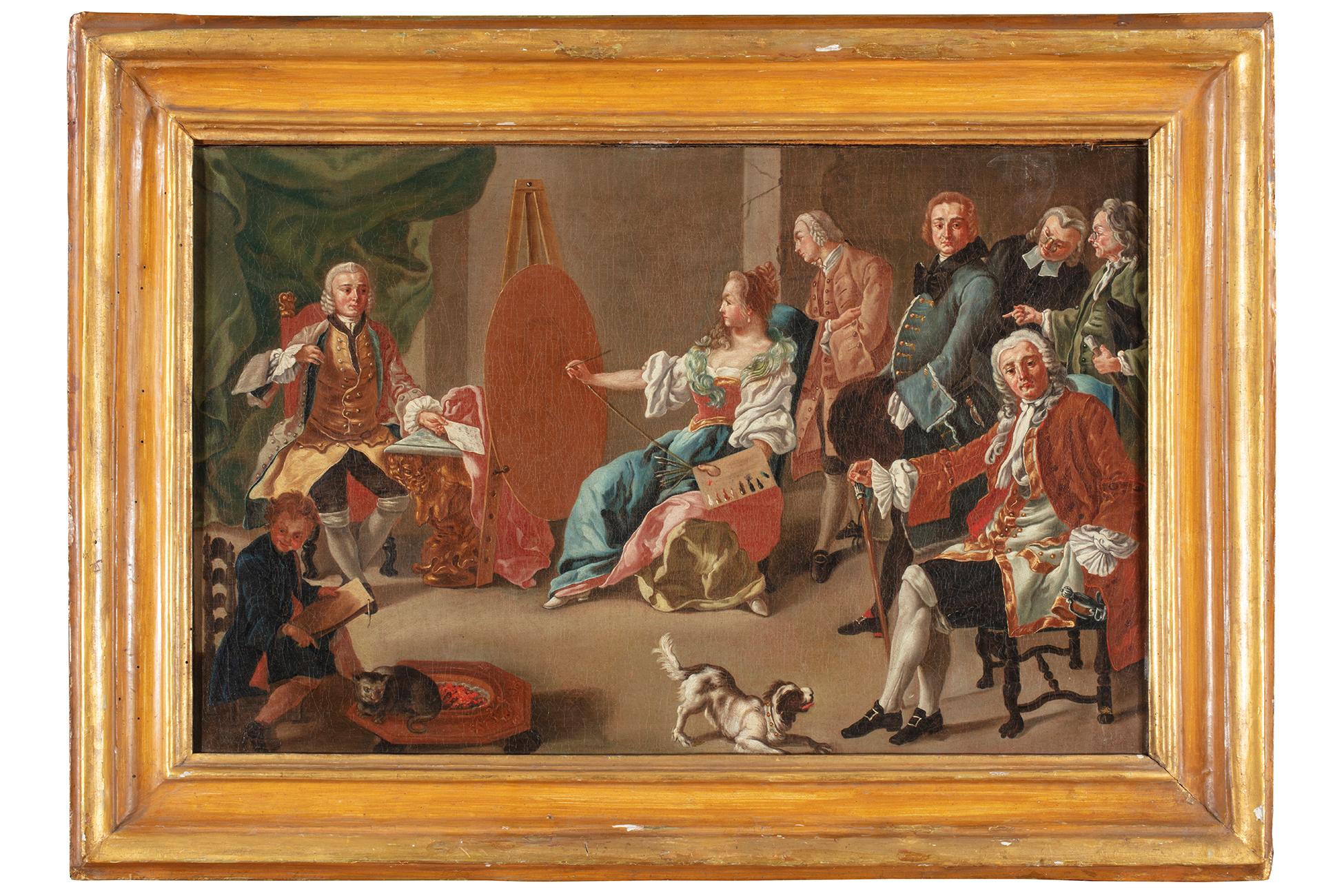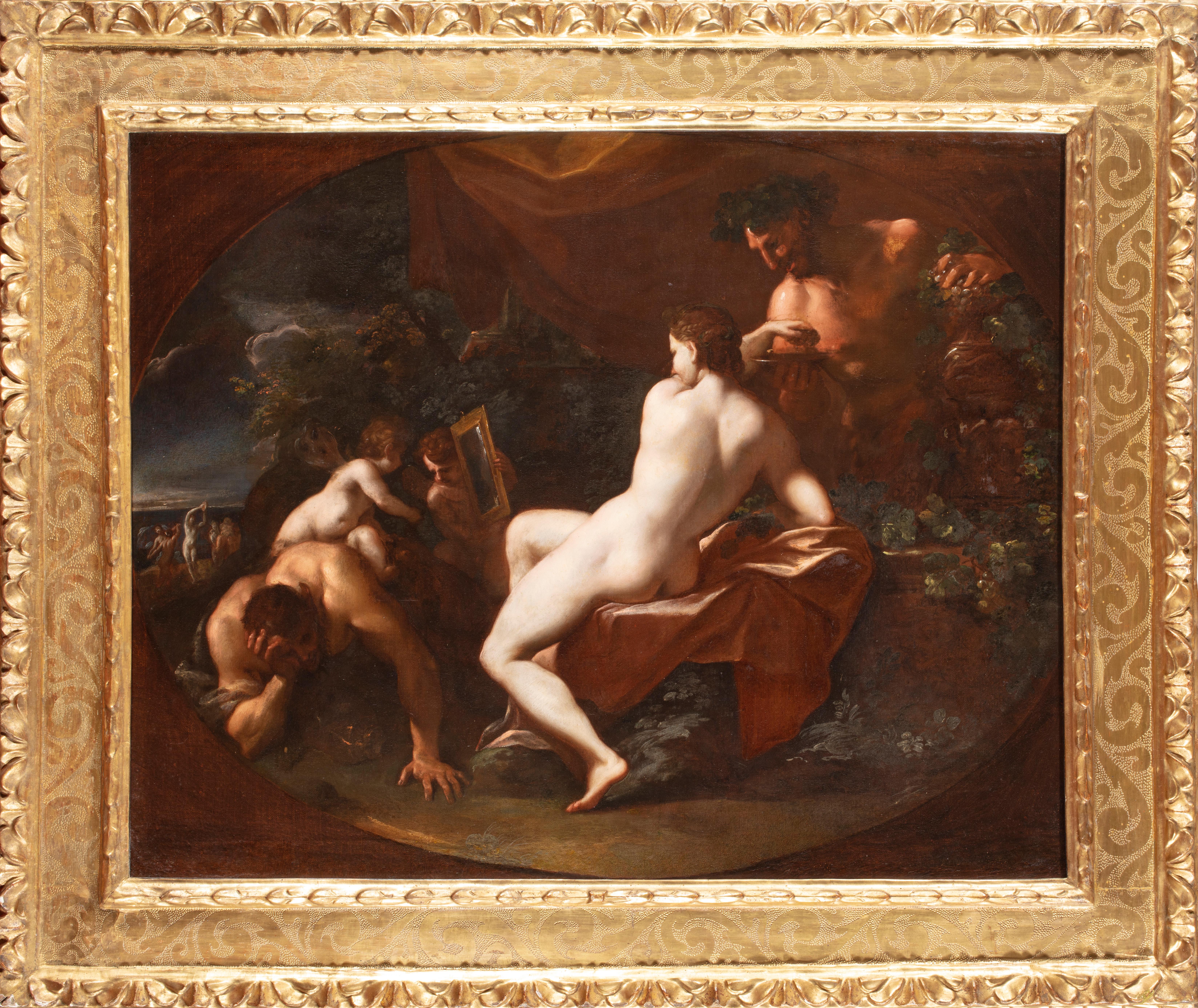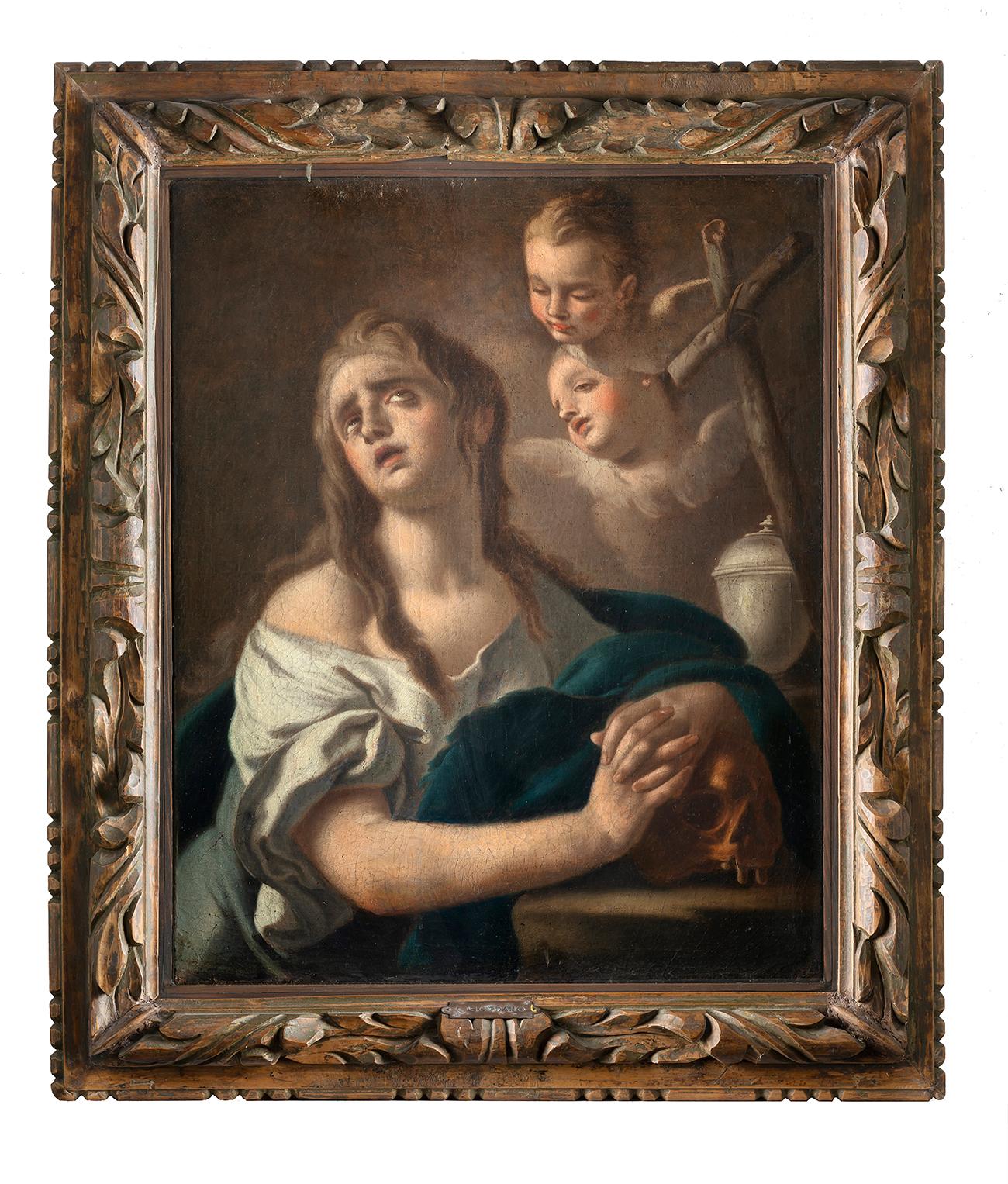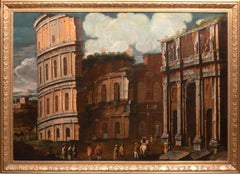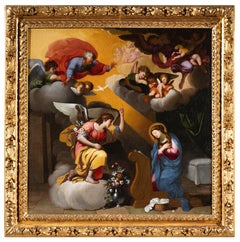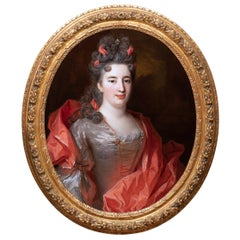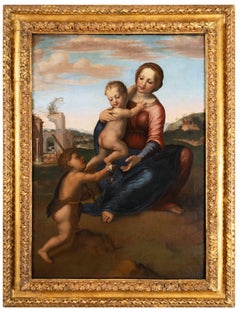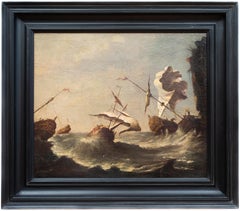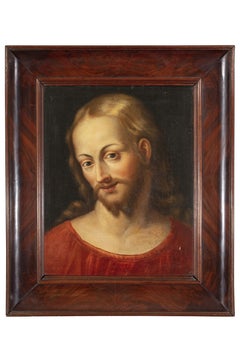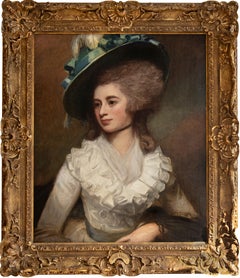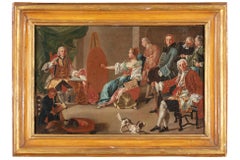Items Similar to Jean-Marc Nattier (1685 - 1766) - Portrait of Charlotte de Hesse-Rheinfels
Want more images or videos?
Request additional images or videos from the seller
1 of 12
Jean-Marc NattierJean-Marc Nattier (1685 - 1766) - Portrait of Charlotte de Hesse-Rheinfels
About the Item
Jean-Marc Nattier (Paris, 1685 - 1766) and his workshop
Portrait of Charlotte de Hesse-Rheinfels
Oil on canvas : h. 44.09 in, w. 38.19 in
18th century carved giltwood framed
Framed : h. 52.36 in, w. 47.63 in
Charlotte de Hesse-Rheinfels (1714-1741), daughter of Landgrave Ernest-Léopold de Hesse-Rheinfels-Rotenburg and Éléonore de Lowenstein-Wertheim and Kazazyan, was Princess of Condé by her marriage in 1728 to Duke Louis-Henri de Bourbon-Condé known as Monsieur le Duc.
The princess is portrayed seated on a canopy of gilded wood trimmed with raspberry red velvet, the body positioned facing forward while the face is turned three-quarters to the left. The face with a thoughtful and thoughtful gaze is awakened by its large gray eyes, the translucent skin with painted cheeks accentuates the effect of a melted execution of the model. Her powdered and tied hair is adorned with an orange veil which goes down on her shoulders. The separation fades between the powdered hair and the face. Dressed in a golden yellow satin dress embellished with multiple rows of white and black lace flounces at the bodice and sleeves, the neckline of her dress reveals her bare throat. The ermine coat lined with blue velvet is placed behind his shoulders, the sides of the coat come back to the front and are arranged in angular folds on his knees. With her right hand, arm bent at the elbow, she caresses her little dog, while the left arm resting on the armrest of the armchair is extended and the index finger of her open hand points to the right. The positions of the arms and the head generate an illusion of diagonal movement allowing to break the static character of portrait. This stretching of the arms horizontally is characteristic of Nattier's works, the figure thus grows in size in the painting by occupying a larger place there. This process carried out by highlighting the elegance of refined gestures increases the natural grace of the young woman. The sober architectural background is composed of a column draped with a green curtain and flattened pilasters with Ionian capitals. The light coming from the right partially illuminates the figure, leaving the left part in shadow. Illuminated, the young woman's dress reflects golden reflections in warm orange tones, while the velvet of the coat broken into angular folds reveals its surface through icy white ridges. This opposition only accentuates the volumes and textures of the fabrics. The facial features under a subtle effect of blurred appear more softened while the pearly white complexions seem illuminated with an inner radiance.
Related works:
Our work is a variant of the painting executed by Jean Marc Nattier, kept at the Museum of Fine Arts in Buenos Aires, Argentina. Signed and dated, but the illegible date makes it impossible to establish a precise dating.
In our version, the dress with a lace corset is preferred to the negligee of the Buenos Aires version, the console is absent. The little dog with the red bow is added on the knees.
The Condés are the first blood princes among Jean Marc Nattier's clients. He began to work in 1729 for the sisters of Louis Henri de Bourbon, Mlle de Clermont and subsequently painted the portrait of Mlle de Charolais in 1731. It is very likely that it was during this period, delighted by the quality of the portraits of his sisters, that the Prince of Condé commissioned the portrait of his wife Charlotte from Nattier. Requested in the 1740s by the royal family, Jean Marc Nattier returned to paint the Condés again in 1753 & 1754.
There are no traces of the signed portrait of Buenos Aires in the inventories of the Condé family. Its known provenance dates back only to the middle of the 20th century.
Regarding our portrait, it appeared in 1905 in Paris in a public sale auction during the dispersal of the collection of the account of R… without further indications on its internal provenance. Undoubtedly remaining on the Parisian art market, the painting was purchased in the 1930s by a wealthy English industrialist for his Monegasque residence and is remained in his posterity until nowdays.
Jean-Marc Nattier (Paris, 1685 - 1766)
Son of a portrait painter and pupil of Rigaud, Nattier began his career as a history painter under the influence of Charles Le Brun and under the tutelage of his godfather, Jean Jouvenet . During a stay in Holland, he was approached to work for Tsar Peter the Great. In 1718, he was received into the Academy. His style is then that of the great French tradition. He uses the resources of the architectural setting and the grandiloquent expression of the characters; its chromaticism is frank. But Nattier does not know success; his ruin at the time of Law's bankruptcy forced him to turn to the more lucrative genre of portraiture. In 1728, he painted the Marshal of Saxe to order and enjoyed a certain favor from then on. It is, at more than forty years, the beginning of a new career which asserts itself with the Portrait of Mlle de Clermont taking the waters (1729). By the choice of subject as by the pictorial means, he established a new way of presenting the portrait, in which the high society of the middle of the 18th century wanted to recognize itself, which had the favor of the great amateurs of the 19th century . century. Elegance of the pose, freshness and clarity of the color, fantasy of the rendering of the accessories add to the serene and joyful expression of the female faces. Superficial works, but pleasing to the eye. The type of mythological portrait is now adopted by the ladies of the aristocracy and Nattier knows Parisian success for a dozen years. Later, received at court, he became the portrait painter of the royal family. The famous series of portraits of the daughters of Louis XV is part of an effort to recreate the portrait by integrating a topical image into the poetic world of Olympus. Nattier thus joins the paths of history painting, speculative and synthetic: the universe recreated in the portraits (such as that of Madame Henriette in Flore) joins the noble data of the allegory.
- Creator:Jean-Marc Nattier (1685 - 1766, French)
- Dimensions:Height: 52.36 in (133 cm)Width: 47.63 in (120.99 cm)
- Medium:
- Movement & Style:
- Period:1730-1739
- Condition:Very good original condition, cleaned and revarnished by our professionnal art restorer.
- Gallery Location:PARIS, FR
- Reference Number:1stDibs: LU2433214036452
About the Seller
No Reviews Yet
Vetted Professional Seller
Every seller passes strict standards for authenticity and reliability
1stDibs seller since 2023
15 sales on 1stDibs
Typical response time: 1 to 2 days
- ShippingRetrieving quote...Shipping from: PARIS, France
- Return Policy
Authenticity Guarantee
In the unlikely event there’s an issue with an item’s authenticity, contact us within 1 year for a full refund. DetailsMoney-Back Guarantee
If your item is not as described, is damaged in transit, or does not arrive, contact us within 7 days for a full refund. Details24-Hour Cancellation
You have a 24-hour grace period in which to reconsider your purchase, with no questions asked.Vetted Professional Sellers
Our world-class sellers must adhere to strict standards for service and quality, maintaining the integrity of our listings.Price-Match Guarantee
If you find that a seller listed the same item for a lower price elsewhere, we’ll match it.Trusted Global Delivery
Our best-in-class carrier network provides specialized shipping options worldwide, including custom delivery.More From This Seller
View AllA 17th c. Italian school, Capriccio with the Colosseum, circle of V. Codazzi
Located in PARIS, FR
A capriccio with the Colosseum in Roma
17th century Italian school
Circle of Viviano Codazzi (1604-1670)
Oil on canvas
Dimensions: h. 35.43 in, w. 51.18 in
Modern 17th century style ...
Category
17th Century Old Masters Landscape Paintings
Materials
Canvas, Oil
The Annunciation, mid-17th century French school
Located in PARIS, FR
The Annunciation
Mid-17th Century French School
Oil on canvas, h. 64 cm, l. 64 cm
17th century carved and giltwood frame decorated with oak leaves and acorns
Framed: h. 80 cm, l. 80...
Category
Mid-17th Century Old Masters Figurative Paintings
Materials
Canvas, Oil
Nicolas de Largillière - Portrait of a Lady, Paris, circa 1695
By Nicolas de Largillière
Located in PARIS, FR
Nicolas de Largillière (Paris, 1656-1746)
Portrait of a lady, circa 1695
Oil on canvas (relined): 76 x 61 cm
Framed: h. 97 cm, l. 82 cm
To be included in the forthcoming catalogue raisonné of the artist by Dominique Brême, director of museum of Sceaux and artist specialist.
Our work presents a majestic French aristocrat against the backdrop of a twilight landscape.
The face seen from the front, the body turned three-quarters, the young woman is portrayed half-length, revealing her slim belted waist.
The elongated face with rosy cheeks, almond-shaped eyes, straight nose and strong chin, solemn expression, the young woman sketches...
Category
1690s Old Masters Figurative Paintings
Materials
Canvas, Oil
17th century Italian school, The Virgin and Child with Saint John the Baptist
Located in PARIS, FR
17th century Italian School
The Virgin and Child with Saint John the Baptist
Oil on canvas
Dimensions: h. 106 cm, l. 77 cm
Important 17th century Italian carved giltwood frame
Fram...
Category
17th Century Old Masters Figurative Paintings
Materials
Canvas, Oil
The Triumph of the Infant Bacchus, workshop of H. Van Balen, 16th c. Antwerp
By Hendrick van Balen
Located in PARIS, FR
The Triumph of the Infant Bacchus,
Workshop of Hendrick Van Balen (1575-1632)
Antwerp, c.1630
Oil on copper, h. 28 cm (11.02 in), w. 35 cm (13.78 in)
A large Roman 17th century golden painted frame
Framed: h. 52 cm (20.47 in.), w. 58 cm (22.83 in)
Our finely painted work depicts The Triumph of the Bacchus as a young boy and is one of the most popular mythological subjects in Antwerp at the beginning of the 17th century. Feasting, wine and fun are the themes that constantly appeal to the public.
Thus unfolds before our eyes on our painting the procession composed of nymphs, baccantes, fauns, satyrs and children, their bodies naked, partially covered with brightly coloured draperies that help to brighten up the parade. Playing various instruments, dancing and drinking, while carrying vases and poles adorned with grapevines, participants to the rhythm of a noisy brass band make their way to an ancient temple standing on the right. The exaggerated gestures convey to us the frenzy of the excited crowd.
The Child Bacchus follows the joyous procession, carried by satyrs and nymphs, crowned with ivy and joyfully raising a cup of wine. In the foreground, the drunken participants leave the procession, the children on the left and the group of bacchantes and satyrs on the right are resting among various objects scattered at their feet: cups, vases, ewers bear witness to the festivities in progress.
In the background, a hilly landscape stretches out on the horizon, a semblance of calm that contrasts with the bustle of the foreground.
The artist strives to multiply the many details, whether it be figures, costumes, flowers or vegetation, in order to demonstrate his know-how and the perfection of his execution.
The acidulous palette with fresh and varied colours is characteristic of Hendrick Van Balen's works.
There are several versions identical to ours with similar dimensions painted by Hendrick Van Balen and his workshop.
Related works:
• Koller Auction, Zurich, 21/09/2007, oil on copper, 28,5 x 37,4 cm.
• Staatliche Kunsthalle, Karlsruhe, Inv. N° 809 (oil on copper, 40 x 53,5 cm)
• Auktionshaus für Altertümer Glückselig, Vienne, 10/05/1932, ( oil on copper, 34 x 42 cm)
• Gemäldegalerie of Pommersfelden, Schloss Weissenstein, oil on panel, 47 x 64 cm
Hendrick Van Balen, Flemish painter, born and died in Antwerp (1575-1632). A pupil of Adam Van Noort, he entered the Guild of St. Luke in 1593, later trained in Italy and was Van Dyck's first teacher. He often painted small figures taken from scenes from the Bible or classical mythology, on paintings whose backgrounds and landscapes were painted by Josse de Momper...
Category
17th Century Old Masters Figurative Paintings
Materials
Copper
Virgin with Child & St John, oil on marble, late 16th century Florentine school
By Andrea Del Sarto
Located in PARIS, FR
Virgin with Child & St John, late 16th c. Florentine school
Late 16th c. Florentine school
Virgin with Child and St John the Baptiste
Oil on white marble,
h. 41,5 cm, w. 32 cm
17th L...
Category
16th Century Old Masters Figurative Paintings
Materials
Marble
You May Also Like
Shipping in Stormy Waters, Attributed to Italian Artist Francesco Guardi
By Francesco Guardi
Located in Stockholm, SE
The splendour of the tragic sea
Francesco Guardi and maritime painting in Venetian art
No Venetian painter was a stranger to the sea. After all, Venice was not only one of the most prominent ports of the Mediterranean, but indeed a city literally submerged in the ocean from time to time. Curiously however, the famous Venetian school of painting showed little interest in maritime motifs, favouring scenes from the iconic architecture of the city rather than seascapes. That is why this painting is a particularly interesting window into not only the painter Francesco Guardi himself – but to the significance of the element of water in art history, in absence as well as in the centre of attention.
Whether it be calm, sunny days with stunning views of the palaces alongside the canals of Venice or – more rarely – stormy shipwrecking tragedies at sea, water as a unifying element is integral to the works of painter Francesco Guardi (1712–1793). During his lifetime, Venetian art saw many of its greatest triumphs with names like Tiepolo or Canaletto gaining international recognition and firmly establishing Venice as one of the most vibrant artistic communities of Europe. While the city itself already in the 18th century was something of an early tourist spot where aristocrats and high society visited on their grand tour or travels, the artists too contributed to the fame and their work spread the image of Venice as the city of romance and leisure to an international audience, many of whom could never visit in person.
Still today, the iconic image of Venice with its whimsical array of palaces, churches and other historic buildings is much influenced by these artists, many of whom have stood the test of time like very well and remain some of the most beloved in all of art history. It was not primarily subtility, intellectual meanings or moral ideals that the Venetian art tried to capture; instead it was the sheer vibrancy of life and the fast-paced city with crumbling palaces and festive people that made this atmosphere so special. Of course, Venice could count painters in most genres among its residents, from portraiture to religious motifs, history painting and much else. Still, it is the Vedutas and views of the city that seems to have etched itself into our memory more than anything else, not least in the tradition of Canaletto who was perhaps the undisputed master of all Venetian painters.
Born into his profession, Francesco lived and breathed painting all his life. His father, the painter Domenico Guardi (1678–1716) died when Francesco was just a small child, yet both he and his brothers Niccolò and Gian Antonio continued in their fathers’ footsteps. The Guardi family belonged to the nobility and originated from the mountainous area of Trentino, not far from the Alps. The brothers worked together on more challenging commissions and supported each other in the manner typical of family workshops or networks of artists. Their sister Maria Cecilia married no other than the artist Giovanni Battista Tiepolo himself, linking the family to the most renowned Venetian name of the time. During almost a decade, Guardi worked in the studio of Michele Giovanni Marieschi, sometimes simply known as Michiel, a painted similar in both style and motif. Canaletto is, however, the artist Guardi is most often compared to since they shared a mutual fascination for depicting the architecture and cityscape of Venice.
During the course of his career, Guardi tried his hand in many different genres. He was as swift in painting landscapes, Vedutas of Venice, sacred motifs, interiors and architectural compositions as he was in a number of other motifs. His style is typical of the Venetian school but also distinct and personal once we look a little closer. There is an absolute certainty in the composition, the choice of which sometimes feels like that of a carefully calculated photograph – yet it is also very painterly, in the best sense of the word: fluid, bold, sensitive and full of character. The brushwork is rapid, intense, seemingly careless and extraordinarily minute at the same time; fresh and planned in a very enjoyable mixture. His interiors often capture the breath-taking spacious glamour of the palaces and all their exquisite decor. He usually constructed the motif through remarkably simple, almost spontaneous yet intuitively precise strokes and shapes. The result was a festive, high-spirited atmospheric quality, far away from the sterile and exact likeness that other painters fell victim to when trying to copy Canaletto.
The painting here has nothing of the city of Venice in it. On the contrary, we seem to be transported far away into the solitary ocean, with no architecture, nothing to hold on to – only the roaring sea and the dangerous cliffs upon which the ships are just moments away from being crushed upon. It is a maritime composition evoking both Flemish and Italian precursors, in the proud tradition of maritime painting that for centuries formed a crucial part of our visual culture.
This genre of painting is today curiously overlooked, compared to how esteemed and meaningful it was when our relationship to the sea was far more natural than it is today. When both people and goods travelled by water, and many nations and cities – Venice among them – depended entirely on sea fare, the existential connection to the ocean was much more natural and integrated into the imagination. The schools and traditions of maritime art are as manifold as there are countries connected to the sea, and all reflect the need to process the dangers and wonders of the ocean.
It could symbolize opportunity, the exciting prospects of a new countries and adventures, prospering trade, beautiful scenery as well as war and tragedy, loss of life, danger and doom. To say that water is ambivalent in nature is an understatement, and these many layers were something that artists explored in the most wondrous ways. Perhaps it takes a bit more time for the modern eye to identify the different nuances and qualities of historic maritime paintings, they may on first impression seem hard to differentiate from each other. But when allowing these motifs to unfold and tell stories of the sea in both fiction and reality – or somewhere in between – we are awarded with an understanding of how the oceans truly built our world.
In Guardi’s interpretation, we see an almost theatrically arranged shipwrecking scene. No less than five ships are depicted right in the moment of utter disaster. Caught in a violent storm, the waves have driven them to a shore of sharp cliffs and if not swallowed by the waves, crushing against the cliffs seems to be the only outcome. The large wooden ships are impressively decorated with elaborate sculpture, and in fact relics already during Guardi’s lifetime. They are in fact typical of Dutch and Flemish 17th century ships, giving us a clue to where he got the inspiration from. Guardi must have seen examples of Flemish maritime art, that made him curious about these particular motifs. One is reminded of Flemish painters like Willem van de Velde and Ludolf Backhuysen, and this very painting has indeed been mistakenly attributed to Matthieu van Plattenberg...
Category
18th Century Old Masters Landscape Paintings
Materials
Canvas, Oil
$46,421 Sale Price
32% Off
Free Shipping
16th Century by Bernardino Detti Face of Christ Oil on Canvas
Located in Milano, Lombardia
Bernardino Detti (Pistoia, Italy, 1498 - 1572)
Title: Face of Christ
Medium: Oil on canvas
Dimensions: without frame 41 x 32 cm - with frame 47 x 55.5 cm
Antique box frame made of solid wood and walnut burl.
Publications: unpublished
The painting by Bernardino Detti (1498 - 1572) depicts the face of Jesus...
Category
16th Century Old Masters Figurative Paintings
Materials
Canvas, Oil
Portrait of Lady Caroline Price
By George Romney
Located in Miami, FL
DESCRIPTION: Perhaps the best Romney in private hands. If Vogue Magazine existed in the late 18th century, this image of Lady Caroline Price would be ...
Category
1970s Old Masters Portrait Paintings
Materials
Oil, Canvas
18th Century by Giuseppe Bonito The Painter's Studio or Allegory of Painting
Located in Milano, Lombardia
Giuseppe Bonito (Castellammare di Stabia, Italy, 1707 - Naples, Italy, 1789)
Title: The Painter's Studio or Allegory of Painting
Medium: Oil on canvas
...
Category
Mid-18th Century Old Masters Figurative Paintings
Materials
Canvas, Oil
17th Century By Domenico Maria Canuti Toilet of Venus with Cupids and Satyrs
Located in Milano, Lombardia
Domenico Maria Canuti (Bologna 1626 - 1684)
Title: Toilet of Venus with Cupids and Satyrs
Medium: Oil on canvas
Dimensions: without frame 79 x 98 cm - ...
Category
Late 17th Century Old Masters Figurative Paintings
Materials
Canvas, Cotton Canvas, Oil
18th Century by Pietro Bardellino Mary Magdalene Painting Oil on Canvas
By Pietro Bardellino
Located in Milano, Lombardia
Pietro Bardellino (Naples, Italy, 1731 – 1806)
Title: Mary Magdalene
Medium: Oil on canvas
Dimensions: without frame 75 x 60 cm – with frame 97 x 82 cm
Antique shaped and carved wood...
Category
Mid-18th Century Old Masters Portrait Paintings
Materials
Oil, Canvas
Recently Viewed
View AllMore Ways To Browse
Raspberries Art
Old Painted Arm
Coat Of Arms Painting
English Female Portrait Paintings
19th Century Portraits English Style
English Female Portraits
Painted Corset
Woman Posing Seated
19th Century Gilded Frames Very Large
Painting Corset
Antique 1930s Dress Dresses
Le Brun
The Godfather Signed
Old Master Style Gilded Frame Painting
Olympus Art
19th Century French Female Portraits
Antique French Gilded Armchairs
Open Back Draped Dress
